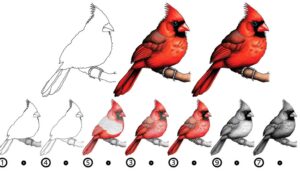How Do Cardinals Raise Their Juvenile?
Cardinals are highly attentive parents who actively raise their juveniles. Both male and female cardinals participate in nest defense and feeding of the young.
The female incubates the eggs for 11-13 days, maintaining ideal warmth and humidity. Upon hatching, the juveniles are altricial and require extensive care, including feeding and protection from predators.
Males frequently provide food while females focus on guarding and nurturing the nestlings. As the juveniles grow, they learn important skills such as foraging and recognizing threats under the supervision of both parents.
As fledglings mature, parental guidance gradually leads to full independence. For more on their nurturing behavior, continue exploring.

Key Takeaways
- Both parents actively defend the nest and protect the juveniles from predators.
- Male cardinals provide food for both the nestlings and fledglings.
- Female cardinals maintain thermal conditions during the incubation period for proper embryo development.
- Parents teach juveniles crucial survival skills, including foraging techniques and threat recognition.
- Juvenile cardinals undergo rapid growth phases and are guided by parents until they achieve self-sufficiency.
Nesting Habits
Cardinals exhibit specific nesting habits, typically selecting dense shrubbery or low tree branches to construct their nests, which are made from twigs, bark strips, and grasses.
These birds prefer locations that offer both concealment and accessibility, ensuring safety from predators while allowing ease of entry and exit.
The nest construction begins with the female cardinal meticulously weaving a base structure with coarse materials, followed by a lining of softer elements like grasses and pine needles to provide warmth and comfort.
The selected site usually ranges from 1 to 15 feet above ground level. This strategic placement in dense vegetation or among thick foliage not only camouflages the nest but also provides a sturdy foundation to withstand environmental challenges.
Egg Laying
During the egg laying phase, female cardinals carefully choose nesting sites that offer ideal protection and environmental conditions for their eggs.
The incubation period usually lasts 11 to 13 days, and during this time, the female is primarily responsible for maintaining the necessary warmth and humidity levels.
This critical period maximizes the proper development of the embryos until hatching.
Nesting Site Selection
In selecting a nesting site for egg laying, Northern Cardinals exhibit a preference for dense foliage and shrubbery which provides both concealment from predators and protection from environmental elements.
Typically, they choose sites that are 3 to 10 feet above the ground, often in shrubs like honeysuckle, dogwood, and rose bushes.
The female cardinal primarily undertakes the task of nest construction using materials such as twigs, bark strips, leaves, and grasses. The nest is usually cup-shaped, providing a secure and stable environment for the eggs.
This strategic site selection and meticulous nest-building behavior are critical for maximizing reproductive success and ensuring the safety and development of their offspring from the egg-laying stage onward.
Egg Incubation Period
Following the detailed construction of the nest, the female Northern Cardinal lays a clutch of eggs, typically numbering between two to five, which she will then incubate for approximately 11 to 13 days. During this period, the female maintains a consistent presence to guarantee ideal thermal conditions for embryo development.
The eggs, pale white with speckled markings, require constant warmth and protection from potential predators. The male cardinal plays an essential supportive role, providing food to the female during incubation. This division of labor ensures that the eggs are rarely left unattended, minimizing the risk of exposure to varying temperatures and inclement weather.
The precise timing of these incubation activities is crucial for the successful hatching of the cardinal's offspring.
Incubation Period
The incubation period for cardinal eggs typically spans 11 to 13 days. During this time, the female primarily undertakes the task of maintaining ideal conditions for embryo development.
The male contributes by providing food and protection, ensuring that the female can remain on the nest with minimal disturbances.
This division of labor highlights the cooperative nature of cardinal parental roles during the critical early stages of their offspring's development.
Duration of Incubation
Cardinals typically undergo an incubation period of 11 to 13 days, during which the female primarily assumes the responsibility of keeping the eggs warm and ensuring their development. This period is vital for the proper embryonic growth of the eggs. The female cardinal maintains a consistent body temperature, which is essential for the viability of the embryos.
Environmental factors, such as temperature and humidity, can influence the exact duration of incubation. The eggs are usually turned periodically by the female to prevent the embryo from sticking to the shell.
Parental Roles Explained
During the incubation period, the female cardinal mainly shoulders the responsibility of maintaining best conditions for the eggs, while the male provides food and protection. The female spends most of her time sitting on the eggs to ensure they remain at an ideal temperature, which is crucial for embryonic development. Meanwhile, the male gathers food and brings it to the female, minimizing her need to leave the nest. This division of labor maximizes the survival chances of the offspring.
Key roles during the incubation period include:
- Egg Temperature Regulation: The female keeps the eggs warm and rotates them for even heat distribution.
- Food Provisioning: The male supplies food to the female.
- Nest Protection: Both parents defend the nest from predators.
- Communication: Vocal signals are used for coordination.
Hatching Process
Incubation of cardinal eggs typically lasts between 11 to 13 days, during which the female diligently maintains ideal temperature and humidity levels to facilitate successful hatching. The meticulous care involves frequent adjustments to position and slight movements to ensure even warmth distribution. The female remains attentive, rarely leaving the nest except for brief feeding intervals.
| Stage | Duration | Key Activities |
|---|---|---|
| Egg-laying | 1-2 days | Female lays 2-5 eggs, one per day |
| Incubation | 11-13 days | Maintaining temperature, humidity, and egg turning |
| Hatching | 24-48 hours | Chicks break through shells, assisted by female |
The precision in these stages guarantees the embryonic development progresses optimally, culminating in the emergence of hatchlings well-prepared for the subsequent stages of growth.
Feeding Chicks
Both male and female cardinals engage in the meticulous feeding of their newly hatched chicks. They provide a diet primarily composed of bugs and protein-rich grains to guarantee rapid growth and development. This diet is essential during the early stages as it supplies necessary nutrients required for robust skeletal and muscular formation.
The feeding process involves frequent trips to forage, ensuring a constant supply of nourishment.
- Bugs: High in protein and easy to digest, ideal for growing chicks.
- Grains: Supplement the diet with crucial fats and proteins.
- Frequency: Chicks are fed every 10-15 minutes during daylight hours.
- Parental Coordination: Both parents alternate feeding to maximize efficiency.
Such dedicated feeding practices underscore the cardinal's commitment to offspring survival.
Parental Roles
In the context of raising their offspring, both male and female cardinals exhibit shared parenting duties, ensuring the survival and development of their juveniles.
The role of male cardinals is particularly remarkable, as they not only help in feeding the chicks but also take on protective responsibilities to safeguard the nest.
This cooperative effort highlights the importance of biparental care in the reproductive success of cardinals.
Shared Parenting Duties
Cardinal parenting involves a collaborative effort where both males and females actively participate in nesting, feeding, and protecting their offspring. This shared approach secures the survival and well-being of their juveniles. The division of duties is meticulously balanced, with each parent fulfilling critical roles that contribute to the growth and development of their young.
Nesting:
Both parents take part in selecting the nest site and constructing the nest.
Feeding:
They share the responsibility of feeding the chicks, with males often sourcing food and females feeding it to the young.
Protection:
Both parents are vigilant in defending the nest from predators.
Teaching:
Parents guide juveniles in learning essential survival skills, such as foraging and recognizing threats.
This cooperative strategy exemplifies the cardinal's dedication to effective parenting.
Role of Male Cardinals
Male cardinals play a central role in the upbringing of their young, particularly in providing food and protection during the vital early stages of development. These vibrant feathered fathers engage in feeding the nestlings and fledglings, ensuring they receive adequate nutrition, which is necessary for growth. Additionally, male cardinals exhibit territorial behavior to safeguard their family from potential predators and rival birds. Their distinctive red plumage often serves as a deterrent, signaling their readiness to defend the nest. This parental investment is essential for the survival and overall fitness of the offspring.
| Role | Description |
|---|---|
| Feeding | Provides food to nestlings and fledglings |
| Protection | Defends territory from predators |
| Signaling | Uses red plumage to deter rivals |
Such behaviors highlight the critical role of male cardinals in juvenile rearing.
Growth Stages
The growth stages of juvenile cardinals encompass several distinct phases, each characterized by specific developmental milestones and behavioral changes.
Initially, hatchlings are altricial, meaning they are born blind, featherless, and entirely reliant on parental care. Within the first week, rapid growth occurs, and pin feathers start to develop.
By the second week, juveniles begin to open their eyes and exhibit more movement within the nest. During the third week, feather development progresses significantly, enabling early attempts at flight.
Observing these stages provides insights into the complex biological processes underpinning avian development.
Fledging Time
As feather development reaches its peak by the third week, juvenile cardinals enter the fledging phase, where they prepare to leave the nest and gradually become more independent. During this critical period, fledglings exhibit increased wing-flapping and hopping behaviors, necessary for strengthening their muscles and improving coordination.
Typically, fledging occurs between 9 to 11 days post-hatching. At this stage, the juveniles' feathers are sufficiently developed to support short flights, although they remain relatively vulnerable. Their survival hinges on their ability to navigate their surroundings and evade predators.
Parental cardinals closely monitor their fledglings, providing crucial guidance and protection. The fledging phase is a pivotal change from nest dependency to the initial stages of self-sufficiency in juvenile cardinals.
Post-Fledging Care
Following the fledgling phase, juvenile cardinals continue to heavily depend on their parents for nourishment and guidance as they adapt to their new surroundings. During this vital period, parental care is essential for the survival and development of the young birds.
Adult cardinals engage in several key activities to support their juveniles:
- Feeding: Parents provide a consistent diet of insects and seeds, essential for the growth and energy needs of juveniles.
- Protection: Adult cardinals remain watchful, shielding their young from predators and environmental hazards.
- Thermoregulation: Parents help regulate the body temperature of the juveniles, especially during cooler weather.
- Vocal Communication: Adults use specific calls to guide and reassure their fledglings, strengthening familial bonds.
These activities collectively guarantee the juveniles' successful adaptation to independence.
Teaching Survival Skills
Adult cardinals engage in a series of strategic behaviors to impart necessary survival skills to their juveniles, ensuring their readiness for independent life. These behaviors include teaching efficient foraging techniques, recognizing suitable food sources, and avoiding predators. The parents demonstrate food handling and selection, providing direct instruction through repeated examples.
Additionally, juvenile cardinals learn to navigate their environment by observing parental flight patterns and territorial boundaries. Vocal communication is also vital; adult cardinals use specific calls to signal danger or guide juveniles toward food. This thorough experiential learning process not only enhances the juveniles' ability to find sustenance but also sharpens their instinctual responses to potential threats, significantly improving their chances of survival in the wild.
Juvenile Independence
Upon mastering essential survival skills, juvenile cardinals gradually begin to assert their independence, venturing further from parental supervision and developing their own foraging and territorial behaviors. This period is marked by several key behaviors indicative of growing independence:
- Foraging Proficiency: Juveniles refine their ability to identify and secure food sources, essential for their survival.
- Territorial Exploration: They start to explore and establish their own territories, often signaling the progression towards adulthood.
- Social Integration: Interactions with other cardinals become more frequent, fostering social skills and mating opportunities.
- Vocal Development: Juvenile cardinals improve their song repertoire, pivotal for communication and mating calls.
These behaviors signify an important phase in their development, laying the groundwork for successful adult life.
Seasonal Parenting
As juvenile cardinals set out on their journey towards independence, the role of seasonal parenting becomes increasingly apparent, highlighting the adaptive strategies parents employ across different times of the year to guarantee the survival and development of their offspring.
During the breeding season, typically from March to September, cardinal parents invest heavily in nest building, incubation, and feeding. Male cardinals often supplement the diet of both the female and the nestlings, ensuring adequate nutrition.
As seasons shift, parental focus shifts to teaching fledglings essential survival skills, such as foraging and predator avoidance. This seasonal adaptability not only maximizes juvenile survival rates but also strengthens their ability to thrive in varying environmental conditions, underscoring the complexity of avian parental care.
Conclusion
Coinciding with the cardinal's complex nesting habits and the careful care provided from egg laying to post-fledging, the development of juvenile independence is a proof of the species' adept parenting skills.
Through a series of well-coordinated efforts in feeding, protection, and the imparting of survival skills, cardinals guarantee the successful progression of their young to self-sufficient adulthood.
This cyclical and seasonal commitment underscores the cardinal's evolutionary success and resilience in different environmental conditions.






